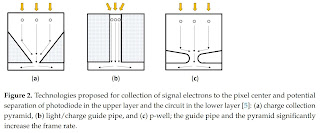"A burst image sensor named Hanabi, meaning fireworks in Japanese, includes a branching CCD and multiple CMOS readout circuits. The sensor is backside-illuminated with a light/charge guide pipe to minimize the temporal resolution by suppressing the horizontal motion of signal carriers. On the front side, the pixel has a guide gate at the center, branching to six first-branching gates, each bifurcating to second-branching gates, and finally connected to 12 (=6×2) floating diffusions. The signals are either read out after an image capture operation to replay 12 to 48 consecutive images, or continuously transferred to a memory chip stacked on the front side of the sensor chip and converted to digital signals. A CCD burst image sensor enables a noiseless signal transfer from a photodiode to the in-situ storage even at very high frame rates. However, the pixel count conflicts with the frame count due to the large pixel size for the relatively large in-pixel CCD memory elements. A CMOS burst image sensor can use small trench-type capacitors for memory elements, instead of CCD channels. However, the transfer noise from a floating diffusion to the memory element increases in proportion to the square root of the frame rate. The Hanabi chip overcomes the compromise between these pros and cons."
Branching Pixel for 1MP, 2.59Gfps Sensor
MDPI paper "A Pixel Design of a Branching Ultra-Highspeed Image Sensor" by Nguyen Hoai Ngo, Kazuhiro Shimonomura, Taeko Ando, Takayoshi Shimura, Heiji Watanabe, Kohsei Takehara, Anh Quang Nguyen, Edoardo Charbon, and Takeharu Goji Etoh from Ritsumeikan University, Osaka University, Kindai University, Hanoi University of Science and Technology, and EPFL presents a new CCD pixel:




0 Response to "Branching Pixel for 1MP, 2.59Gfps Sensor"
Post a Comment